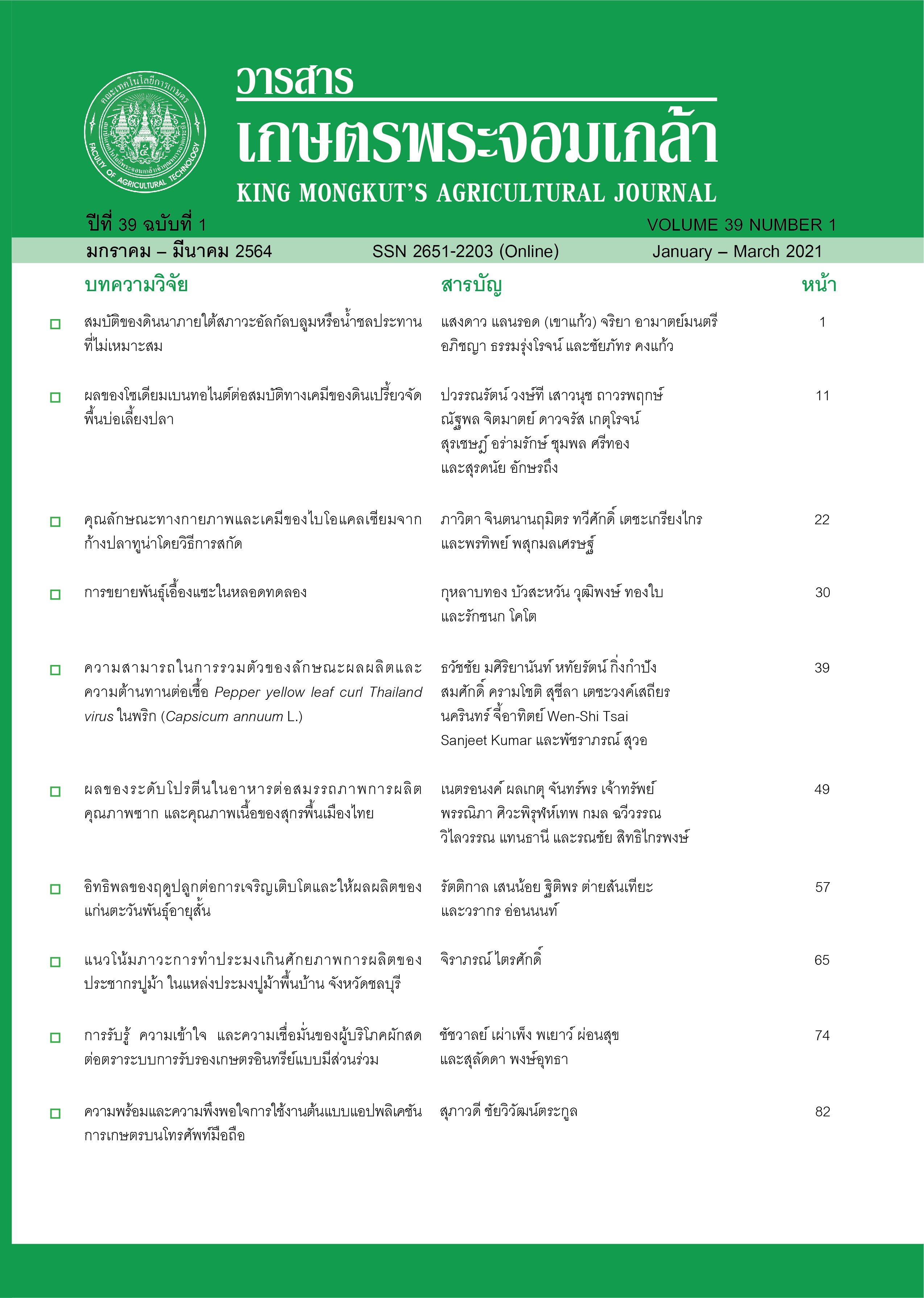Combining Ability Analysis for Yield and Resistance to Pepper yellow leaf curl Thailand virus in Chilli Pepper (Capsicum annuum L.)
Main Article Content
Abstract
The pepper yellow leaf curl Thailand virus (PepYLCTHV) is one of economic importance as it has a negative impact on chili pepper production. The use of chilli pepper resistance to PepYLCTHV is a sustainability strategy for controlling the disease. Therefore, the objective of this experiment was to study about the combining ability of pepper varieties with regard to yield and resistance to PepYLCTHV. Thirteen F1hybrids testcrosses were obtained by testcross mating design, and they were compared with 14 parental lines and a susceptibility check (KM-P13001-4). The study was of randomized complete block design (RCBD) with three replications and five plants per replication. The results showed that the Khaekdam varieties had the highest general combining ability (GCA) value for fresh yield characteristics and dry yield at 170.43 and 54.84, respectively. For the GCA value of pepper yellow leaf curl virus disease, the Huareua-7 variety showed the lowest value at -1.54, which was suitable for development of a tolerant variety. Four F1-hybrids, KM-P13052-10-2 x 9853-123, KM-P13052-8-2 x 9853-123, Yodsonkem 80 x 9853-123 and PP0537-7504 x 9853-123 showed the highest heterosis values in fresh yield base on %MP as 148.98%, 257.96%, 46.56% and 68.63%, respectively. %HP were 140.60%, 239.47%, 23.08% and 45.76% respectively. However, all 13 hybrids showed susceptibility to the disease, so it was concluded that resistance to chili pepper disease was controlled by a recessive gene. In addition, the Huareua-7 x 9853-123 hybrid showed the lowest disease level score of 3.3, and the lowest percentage heterosis of -28.57. The results suggest that this hybrid is suitable for the development of chilli pepper varieties that are resistant to the PepYLCTHV virus.
Article Details
King Mongkut's Agricultural Journal
References
ญาณิศา แสงสอดแก้ว. 2561. สมรรถนะการรวมตัวของพริก (Capsicum annuum L.) ต้านทานต่อโรคไวรัสใบหงิกเหลืองพริก. วิทยานิพนธ์, มหาวิทยาลัยขอนแก่น.
ปราโมทย์ พรสุริยา. 2557. การวิเคราะห์ทางไบโอเมตริกในการปรับปรุงพันธุ์พืช. กรุงเทพ: โอ. เอส. พริ้นติ้ง เฮ้าส์.
พัชราภรณ์ สุวอ และสุชีลา เตชะวงค์เสถียร. 2557. สมรรถนะการรวมตัวทั่วไปและการรวมตัวเฉพาะของลักษณะต้านทานโรคแอนแทรกโนส
ในพริกชนิด Capsicumannuum L. แก่นเกษตร 42 (ฉบับพิเศษ 3): 935-940.
พัชราภรณ์ สุวอ. 2560. โรคไวรัสใบหงิกเหลืองในพริก และแนวทางในการจัดการโรค. วารสารเกษตรพระจอมเกล้า 35(2): 147-152.
Anaya-Lopez, J. L., Torres-Pacheco, I., Gonzalez-Chavira, M., Garzon-Tiznado, J. A., and Pons-Hernandez, J. L. 2003.
Resistant to Geminivirus mixed infections in Mexican wild peppers. Horticultural Science 38(2): 251-255.
Barchanger, D. W., Jeeatid, N., Lin, S. W., Wang, Y. W., Lin, T. H., Chan, Y. L., and Kenyon, L. 2019. A novel source of resistance to Pepper yellow leaf curl Thailand virus (PepYLCTHV) (Begomovirus) in chile pepper. International Society for Horticultural Science 54(12): 2149-2149.
Chatchawankanphanich, O., and Maxwell, D. P. 2002. Tomato leaf curl Karnataka virus from Bangalore, India, appears to be
a recombinant Begomovirus. Phytopathology 92(6): 637-645.
Chiemsombat, P., Srikamphung, B., Yule, S., and Srinivasan, R. 2018. Begomoviruses associated to pepper yellow leaf curl disease in Thailand. Journal of Agricultural Research 3(7): 1-11.
Firdaus, S., Heusden, A. V., Harpenas, A., Supena, E. D. J., and Vosman, B. 2011. Identification of silverleaf whitefly resistance
in pepper. Journal of Plant Breeding 130(6): 708-714.
Ghanim, M., Morin, S., Zeidan, M., and Czosnek, H. 1998. Evidence for transovarial transmission of Tomato yellow leaf curl virus
by its vector, the whitefly Bemisiatabaci. Journal of Virology 240: 295-303.
Ganefianti, D. W., Hidayat, S. H., and Syukur, M. 2015. Genetic study of resistance to Begomovirus on chili pepper by
Hayman’s diallel analysis. International Journal on Advanced Science, Engineering and Information Technology 5(6):
-432.
Ghanim, M., and Czosnek, H. 2000. Tomato yellow leaf curl geminivirus (TYLCV-Is) is transmitted among whitefly (Bemisiatabaci)
in a sex-related manner. Journal of Virology 74(10): 4738-4745.
Jamsari, J., and Pedri, J. 2013. Complete nucleotide sequence of DNA A-like genome and DNA-B of monopartite
Pepper yellow leaf curl virus, adominant begomovirus infecting Capsicum annnuum L. in West Sumatra Indonesia.
Asian Journal of Plant Pathology 7(1): 1-14.
Kenyon, L., Tsai, W. S., Shih, S. L., and Lee, L. M. 2014. Emergence and diversity of begomoviruses infecting solanaceous crops
in East and Southeast Asia. Virus Research 186: 104-113.
Kumar, S., Kumar, S., Sing, M., Sing, A. K., and Rai, M. 2006. Identification of host plant resistance to Pepper leaf curl virus in chilli (Capsicum species). Scientia Horticulturae 110: 359-361.
Kumar, S., Kumar, R., Kumar, S., Singh, M., Rai, A. B., and Rai, M. 2009. Reaction of Pepper leaf curl virus field resistance of chilli (Capsicum annuum L.) genotypes under challenged condition. Vegetable Science 36(2): 17-22.
Rai, V. P., Kumar, R., Singh, A. K., and Kumar, S. 2014. Monogenic recessive resistance to Pepper leaf curl virus in an interspecific cross of Capsicum. Scientia Horticulturae 172: 34-38.
Sprague, G. F., and Tatum, L. A. 1942. General VS. specific combining ability in single crosses of corn. SIAM-ASA Journalon Uncertainty Quantification 34: 923-932.
Tsai, W. S., Shih, S. L., Kenyon, L., Green, S. K., and Jan, F. J. 2011. Temporal distribution and pathogenicity of the predominant tomato-infecting begomoviruses in Taiwan. Plant Pathology 60: 787-779.


